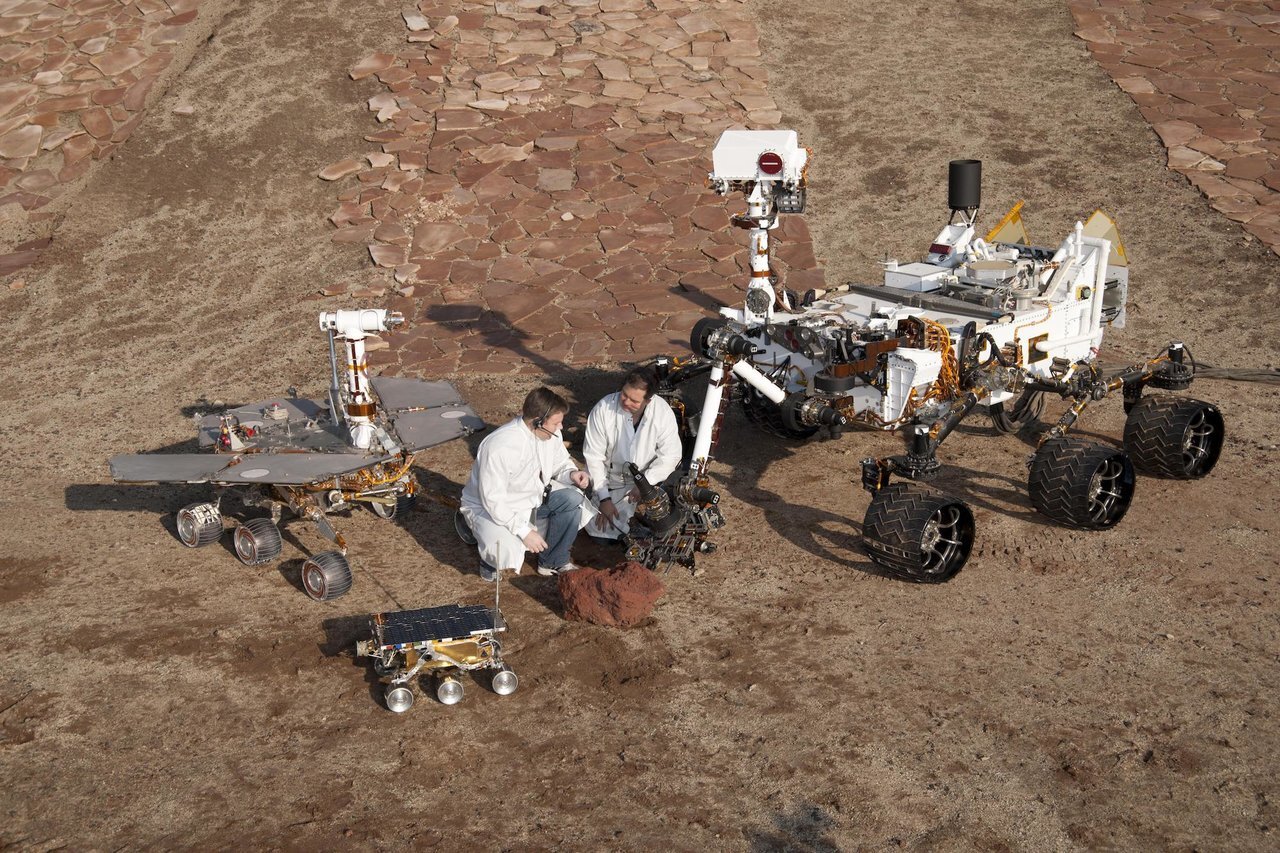News | July 3, 2017
10 Things: July 3

Two spacecraft engineers crouch with a group of vehicles providing a comparison of three generations of Mars rovers developed at NASA's Jet Propulsion Laboratory, Pasadena, Calif. The setting is JPL's Mars Yard testing area.
Bring out the cake and candles! There's an extra reason to celebrate this Fourth of July: We marked the 20th anniversary of Pathfinder's landing on Mars. NASA has had an active robotic presence there ever since—in fact, no one under 20 has experienced a day without NASA at Mars—but the Pathfinder mission was the first-ever robotic rover to explore the Red Planet. Below are 10 things to know about this iconic mission as we celebrate two decades of unprecedented science and discovery.
1. A date to remember. Pathfinder launched from Cape Canaveral, Florida on Dec. 4, 1996 and landed at Mars' Ares Vallis on July 4, 1997. The landing site, an ancient flood plain in Mars' northern hemisphere, is among the rockiest parts of the planet. Scientists chose it because they believed it was a relatively safe surface to land on and contained a wide variety of rocks deposited during a catastrophic flood.
2. Precious cargo. Pathfinder delivered to Mars a tiny, 23-pound (11.5 kilogram) rover named Sojourner, which carried scientific instruments to analyze the Martian atmosphere, climate and geology. To put its small size in perspective, the mechanisms at the end of the Curiosity Rover's robotic arm are heavier than all of Sojourner. You can check out a 360 video of Pathfinder and Sojourner here.
3. Who named the rover? The name Sojourner was chosen after a year-long, worldwide competition in which students up to 18 years old were invited to write about a historical heroine and how she would translate their accomplishments to the Martian environment. Twelve-year-old Valerie Ambroise of Bridgeport, Connecticut submitted the winning essay on Sojourner Truth, a Civil War-era abolitionist who made it her mission to "travel up and down the land" advocating for the rights of all people to be free and participate fully in society.
4. Quite the entrance. Pathfinder's landing was innovative and unprecedented. It entered the thin Martian atmosphere assisted by parachute to slow its descent and with a giant system of airbags to cushion the impact. This mission marked the first time this airbag technique was used. Spirit and Opportunity later used the same method successfully.
5. Mobile matters. The wireless modem between Pathfinder and Sojourner was a commercial, off-the-shelf product. The project team acquired several and stress-tested them until they found the best ones to send off to Mars.
6. It's in the details. Sojourner had bumpers—actual mechanical fenders—painted with black and white stripes. It also had two forward-facing black-and-white cameras, and one rear-facing camera (all one-third of a Megapixel). And Sojourner's tiny wheels measured just 12.5 centimeters in diameter.
7. Viral-worthy. Pathfinder was widely regarded as one of the first "internet sensations." There was so much web traffic from around the world, the entire internet backbone of France crashed under the load.
8. We're getting warmer. Among the many scientific discoveries from Pathfinder and Sojourner: Rounded pebbles and cobbles at the landing site suggested that Mars might have had running water during a warmer past when liquid water was stable on the planet. Early morning water ice clouds also were seen in the lower atmosphere.
9. Long live the mission. The lander and the rover both outlived their design lives—the lander by nearly three times, and the rover by 12 times.
10. Pathfinder's photo album. Go back in time and see historical photographs of Pathfinder's assembly process here.


